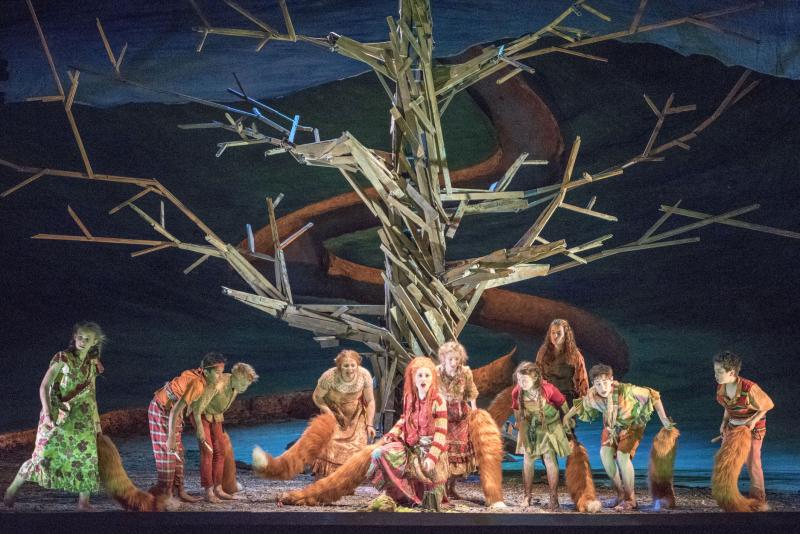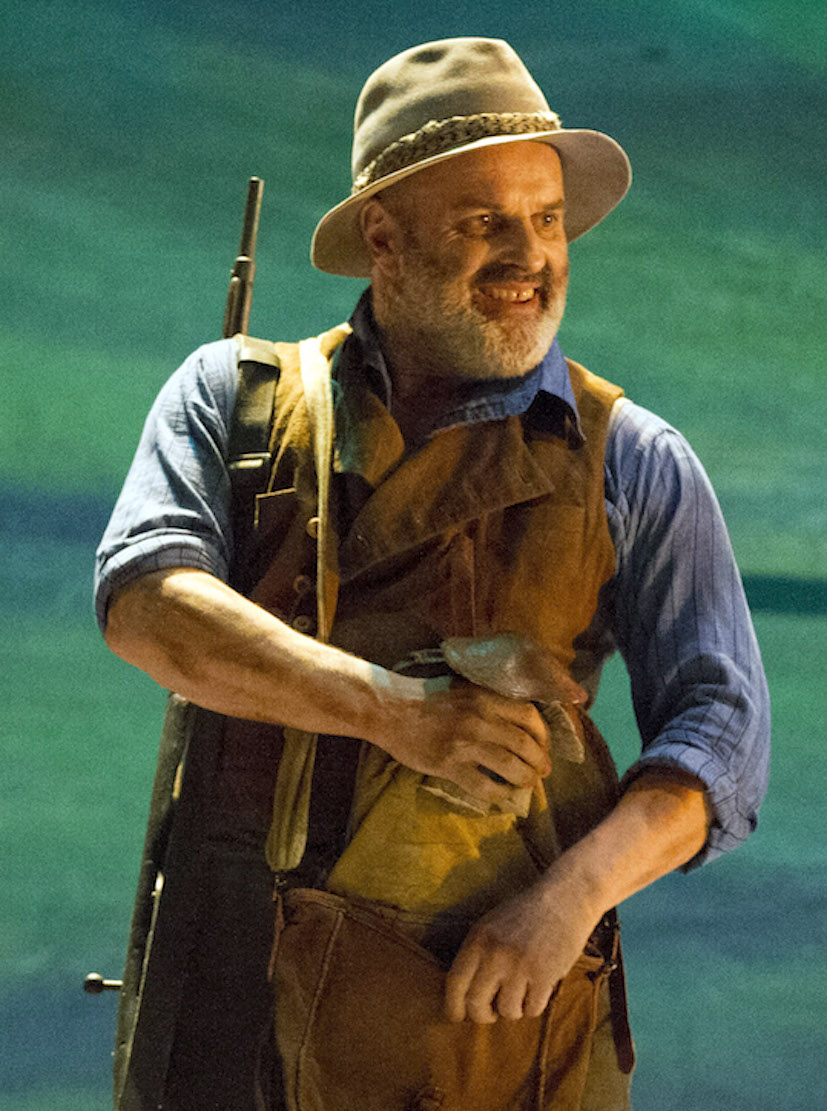The Cunning Little Vixen, Glyndebourne | reviews, news & interviews
The Cunning Little Vixen, Glyndebourne
The Cunning Little Vixen, Glyndebourne
Janáček’s comic strip opera revived with its musical energy and visual wit intact

Is The Cunning Little Vixen a jolly children’s pantomime, or is it a searching study of issues of life and death, Man and Nature? The answer, naturally, is that it’s both. Children dress up as animals, and sing and prance about. But at the same time grown-ups (both animal and human) dream and fantasize, couple and procreate, hunt and kill. Remarkably, it’s a tragedy that leaves no bitter taste. The heroine dies, but Nature goes on.
Other productions have drawn attention to the work’s menopausal aspect, the way its central human character, the Forester, sees the renewal of life in the forest as a mirror of his own fading sexuality. But Still makes no bones about the work’s physicality as such. Although, as David Nice observed in his review of the production when it was new, not everything in this intricate fancy-dress display is entirely clear, one thing is very plain, and that is the sensuality of the human characters’ relation to the natural world.
The design achieves unforgettable effects with a backcloth that looks like a vertical Cresta Run
The Forester (Christopher Purves, or his double) embraces the Vixen; the long love duet between the Fox (Alžběta Poláčková) and the Vixen (Elena Tsallagova) that (nearly) ends the second act is delivered with a passionate physicality that would hardly be out of place in Act II of Tristan. We’re many a mile here from the cartoon strip that was Janáček’s source. This is adult drama in anthropomorphic dress, superbly committed under conductor Jakub Hrůša, and with a string of memorable vignettes from individuals too numerous to list.
It remains, nevertheless, an enchanting spectacle in its own right, designed with unfailing wit, colour and inventiveness by Tom Pye (the sets), Dinah Collin (the costumes), and Paule Constable (the lighting). Pye and Collin achieve unforgettable effects with a backcloth that looks like a kind of vertical Cresta Run up and down which the animals clamber and tumble, and with a gnarled central tree out of which creatures drop like spiders on strands of cobweb and under which the badger (Alexander Vassiliev) lives in his sett until evicted by Tsallagova’s ineffably self-assured Vixen.
 Costume after costume says something witty and essential about its wearer, from the vain and arrogant foxes with their portable brushes to the mosquito (Colin Judson), who bites the Forester with a safety-pin proboscis. Similarly the dances that are such a feature of the score (by choreographer Mike Ashcroft) have all the buzz and tumult of hot summer afternoons in the wild wood. This is one of the few operas that give director and designer licence to invent without risk of subversion, and here they take it with relish.
Costume after costume says something witty and essential about its wearer, from the vain and arrogant foxes with their portable brushes to the mosquito (Colin Judson), who bites the Forester with a safety-pin proboscis. Similarly the dances that are such a feature of the score (by choreographer Mike Ashcroft) have all the buzz and tumult of hot summer afternoons in the wild wood. This is one of the few operas that give director and designer licence to invent without risk of subversion, and here they take it with relish.
Hrůša’s reading is from the start robust; the delicacy, he is telling us, is there in the score and needs no special underlining. Above all, it’s a performance that moves, in both senses, with energy and emotional intensity. The orchestral playing (by the London Philharmonic) would be impossible to better. And the central performances are perfection: Tsallagova irresistible as the Vixen Sharpears, sexy and nubile, vocally seductive; Purves (pictured above), a Forester no better than he should be in human company but in the forest a thinker and feeler, profoundly touching in his final soliloquy about the rolling seasons; Poláčková a fine, eloquent Fox; Judson a village schoolmaster to the life (as well as the Badger, one of two or three doublings authorized by Janáček and taken on this occasion).
Janáček was 70, and in love with a much younger woman, when The Cunning Little Vixen was staged in Prague in 1924. He surely saw himself in it and earthed his emotions through it. And perhaps this, in the end, is the source of its secret charge, so beautifully tapped in this revival.
The future of Arts Journalism
You can stop theartsdesk.com closing!
We urgently need financing to survive. Our fundraising drive has thus far raised £49,000 but we need to reach £100,000 or we will be forced to close. Please contribute here: https://gofund.me/c3f6033d
And if you can forward this information to anyone who might assist, we’d be grateful.

Subscribe to theartsdesk.com
Thank you for continuing to read our work on theartsdesk.com. For unlimited access to every article in its entirety, including our archive of more than 15,000 pieces, we're asking for £5 per month or £40 per year. We feel it's a very good deal, and hope you do too.
To take a subscription now simply click here.
And if you're looking for that extra gift for a friend or family member, why not treat them to a theartsdesk.com gift subscription?
more Opera
 La bohème, Opera North review - still young at 32
Love and separation, ecstasy and heartbreak, in masterfully updated Puccini
La bohème, Opera North review - still young at 32
Love and separation, ecstasy and heartbreak, in masterfully updated Puccini
 Albert Herring, English National Opera review - a great comedy with depths fully realised
Britten’s delight was never made for the Coliseum, but it works on its first outing there
Albert Herring, English National Opera review - a great comedy with depths fully realised
Britten’s delight was never made for the Coliseum, but it works on its first outing there
 Carmen, English National Opera review - not quite dangerous
Hopes for Niamh O’Sullivan only partly fulfilled, though much good singing throughout
Carmen, English National Opera review - not quite dangerous
Hopes for Niamh O’Sullivan only partly fulfilled, though much good singing throughout
 Giustino, Linbury Theatre review - a stylish account of a slight opera
Gods, mortals and monsters do battle in Handel's charming drama
Giustino, Linbury Theatre review - a stylish account of a slight opera
Gods, mortals and monsters do battle in Handel's charming drama
 Susanna, Opera North review - hybrid staging of a Handel oratorio
Dance and signing complement outstanding singing in a story of virtue rewarded
Susanna, Opera North review - hybrid staging of a Handel oratorio
Dance and signing complement outstanding singing in a story of virtue rewarded
 Ariodante, Opéra Garnier, Paris review - a blast of Baroque beauty
A near-perfect night at the opera
Ariodante, Opéra Garnier, Paris review - a blast of Baroque beauty
A near-perfect night at the opera
 Cinderella/La Cenerentola, English National Opera review - the truth behind the tinsel
Appealing performances cut through hyperactive stagecraft
Cinderella/La Cenerentola, English National Opera review - the truth behind the tinsel
Appealing performances cut through hyperactive stagecraft
 Tosca, Royal Opera review - Ailyn Pérez steps in as the most vivid of divas
Jakub Hrůša’s multicoloured Puccini last night found a soprano to match
Tosca, Royal Opera review - Ailyn Pérez steps in as the most vivid of divas
Jakub Hrůša’s multicoloured Puccini last night found a soprano to match
 Tosca, Welsh National Opera review - a great company reduced to brilliance
The old warhorse made special by the basics
Tosca, Welsh National Opera review - a great company reduced to brilliance
The old warhorse made special by the basics
 BBC Proms: The Marriage of Figaro, Glyndebourne Festival review - merriment and menace
Strong Proms transfer for a robust and affecting show
BBC Proms: The Marriage of Figaro, Glyndebourne Festival review - merriment and menace
Strong Proms transfer for a robust and affecting show
 BBC Proms: Suor Angelica, LSO, Pappano review - earthly passion, heavenly grief
A Sister to remember blesses Puccini's convent tragedy
BBC Proms: Suor Angelica, LSO, Pappano review - earthly passion, heavenly grief
A Sister to remember blesses Puccini's convent tragedy
 Orpheus and Eurydice, Opera Queensland/SCO, Edinburgh International Festival 2025 review - dazzling, but distracting
Eye-popping acrobatics don’t always assist in Gluck’s quest for operatic truth
Orpheus and Eurydice, Opera Queensland/SCO, Edinburgh International Festival 2025 review - dazzling, but distracting
Eye-popping acrobatics don’t always assist in Gluck’s quest for operatic truth

Add comment